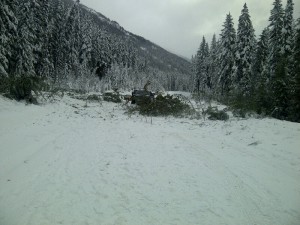
After a recent spate of fatal accidents and calls from the Opposition, the Province announced last week that all of Hwy 16 and Hwy 97 will be upgraded to the highest level of winter maintenance.
Doug Donaldson, NDP MLA for Stikine, had been calling for the upgrade to the highways because he says he’s seen more traffic, especially commercial, in his area around Smithers and Terrace in the last few years. He notes the BC Liberals have said major projects coming on-line in the north like mines and proposed liquid natural gas projects are going to generate revenue for services.
“We want to make sure that we get our fair share of that revenue in the north,” Donaldson told the Goat.
It’s not a matter of choice for us in the north, Donaldson says; we often don’t have any public transit options, and road maintenance is something people encounter on a daily basis.
CBC reported there had been 16 fatalities on Highway 16 between November and mid-January this year; another accident on Highway 16 two weeks ago claimed the life of a New Hazelton woman.
Highway 5 and the section of Highway 16 between the Alberta border and Tete Jaune are already Class A roads, which requires the fastest response times and lowest threshold for snow accumulations by maintenance contractors. Sections of the highways through Prince George are also Class A, but the section between Tete Jaune and Prince George, as well as other sections of both highways outside the city are currently Class B – which means slower response times and higher thresholds of snow are allowed by the province.
Ministry of Transportation and Infrastructure says the change will make the entire Highway 16 corridor from Prince Rupert to the Alberta border Class A, as well as Highway 97 from Cache Creek to Fort St John. The changes are expected to be in effect by mid-to-late February, and the ministry says they represent a significant increase in the maintenance commitment for both highways, which will result in quicker response times, more plowing, snow removal and salt and sand applications.
For example, the ministry says the maximum allowable accumulation of snow in one lane each direction is four centimeters for a Class A road, or six centimeters for Class B. The times for applying sand and salt after a snowfall is five hours for Class A, eight for Class B; and complete patrols of highways during snowfalls have to be done in four hours for Class A, verses eight for Class B.
“This is great news for the thousands of people who live and work in our region, many of whom travel frequently in some very challenging weather conditions,” says Shirley Bond, MLA for Prince George-Valemount in a statement from the province.
Lakes District Maintenance, the contractor for the Robson area, would not comment on what the change will mean for them but the ministry says they are meeting with their maintenance contractors, and staffing and equipment levels needed for the increased service will be part of those discussions. The ministry says their contracts include provisions for maintenance classification changes and the associated costs.
The province says these highways are critical corridors supporting liquefied natural gas development and other industrial growth in the North, and the Government of B.C. has invested $129 million in improvements and upgrades on Highway 16 in the past four years.
Road classifications are determined by number and type of users as well as other factors, says the ministry. Higher class roads and arterials are addressed for maintenance first, followed by roads supporting school busses and industry, and all other roads thereafter. Ministry staff patrols Highway 16 daily and 24-hours-a-day in severe weather, and works closely with maintenance contractors to ensure standards are maintained.
Ministry engineering staff monitors traffic volumes on an annual basis with a detailed analysis every three years, and it says vehicle volumes in the Robson area have remained consistent over the last five years. It says any significant changes would be identified and assessed immediately to endure continued safety and reliability of the highway.



